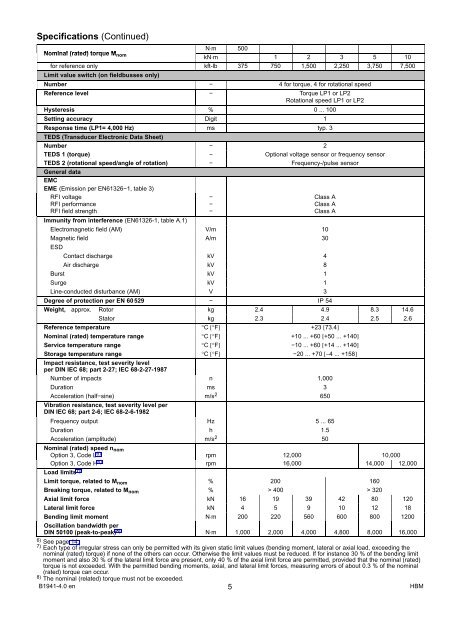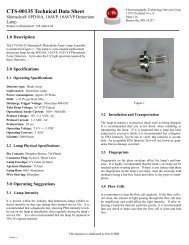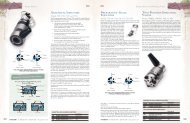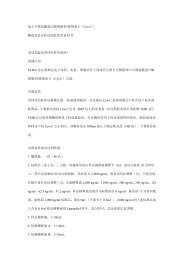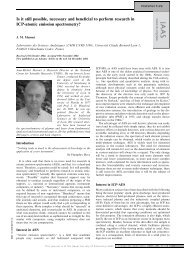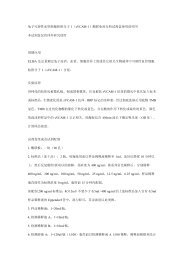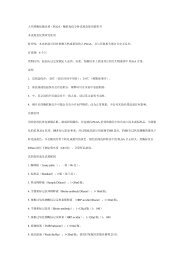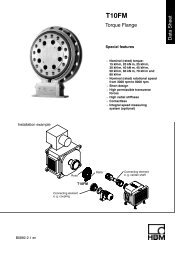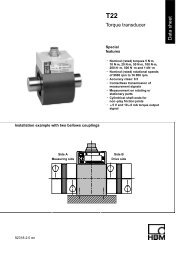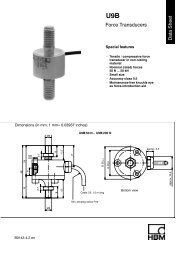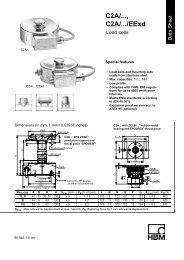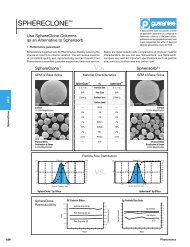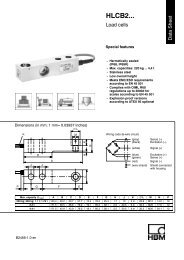Digital Torque Transducer Data Sheet
Digital Torque Transducer Data Sheet
Digital Torque Transducer Data Sheet
Create successful ePaper yourself
Turn your PDF publications into a flip-book with our unique Google optimized e-Paper software.
Specifications (Continued)<br />
N⋅m 500<br />
Nominal (rated) torque M nom<br />
kN⋅m 1 2 3 5 10<br />
for reference only kft-lb 375 750 1,500 2,250 3,750 7,500<br />
Limit value switch (on fieldbusses only)<br />
Number − 4 for torque, 4 for rotational speed<br />
Reference level − <strong>Torque</strong> LP1 or LP2<br />
Rotational speed LP1 or LP2<br />
Hysteresis % 0 ... 100<br />
Setting accuracy Digit 1<br />
Response time (LP1= 4,000 Hz) ms typ. 3<br />
TEDS (<strong>Transducer</strong> Electronic <strong>Data</strong> <strong>Sheet</strong>)<br />
Number − 2<br />
TEDS 1 (torque) − Optional voltage sensor or frequency sensor<br />
TEDS 2 (rotational speed/angle of rotation) − Frequency-/pulse sensor<br />
General data<br />
EMC<br />
EME (Emission per EN61326−1, table 3)<br />
RFI voltage<br />
RFI performance<br />
RFI field strength<br />
Immunity from interference (EN61326-1, table A.1)<br />
−<br />
−<br />
−<br />
Class A<br />
Class A<br />
Class A<br />
Electromagnetic field (AM) V/m 10<br />
Magnetic field A/m 30<br />
ESD<br />
Contact discharge kV 4<br />
Air discharge kV 8<br />
Burst kV 1<br />
Surge kV 1<br />
Line-conducted disturbance (AM) V 3<br />
Degree of protection per EN 60529 − IP 54<br />
Weight, approx. Rotor kg 2.4 4.9 8.3 14.6<br />
Stator kg 2.3 2.4 2.5 2.6<br />
Reference temperature °C [°F] +23 [73.4]<br />
Nominal (rated) temperature range °C [°F] +10 ... +60 [+50 ... +140]<br />
Service temperature range °C [°F] −10 ... +60 [+14 ... +140]<br />
Storage temperature range °C [°F] −20 ... +70 [−4 ... +158]<br />
Impact resistance, test severity level<br />
per DIN IEC 68; part 2-27; IEC 68-2-27-1987<br />
Number of impacts n 1,000<br />
Duration ms 3<br />
Acceleration (half−sine) m/s 2 650<br />
Vibration resistance, test severity level per<br />
DIN IEC 68; part 2-6; IEC 68-2-6-1982<br />
Frequency output Hz 5 ... 65<br />
Duration h 1.5<br />
Acceleration (amplitude) m/s 2 50<br />
Nominal (rated) speed n nom<br />
Option 3, Code L 6) rpm 12,000 10,000<br />
Option 3, Code H 6) rpm 16,000 14,000 12,000<br />
Load limits 7)<br />
Limit torque, related to M nom % 200 160<br />
Breaking torque, related to M nom % > 400 > 320<br />
Axial limit force kN 16 19 39 42 80 120<br />
Lateral limit force kN 4 5 9 10 12 18<br />
Bending limit moment N⋅m 200 220 560 600 800 1200<br />
Oscillation bandwidth per<br />
DIN 50100 (peak-to-peak) 8) N⋅m 1,000 2,000 4,000 4,800 8,000 16,000<br />
6) See page 14.<br />
Each type of irregular stress can only be permitted with its given static limit values (bending moment, lateral or axial load, exceeding the<br />
nominal (rated) torque) if none of the others can occur. Otherwise the limit values must be reduced. If for instance 30 % of the bending limit<br />
moment and also 30 % of the lateral limit force are present, only 40 % of the axial limit force are permitted, provided that the nominal (rated)<br />
torque is not exceeded. With the permitted bending moments, axial, and lateral limit forces, measuring errors of about 0.3 % of the nominal<br />
(rated) torque can occur.<br />
8) The nominal (related) torque must not be exceeded.<br />
B1941-4.0 en<br />
5<br />
HBM


